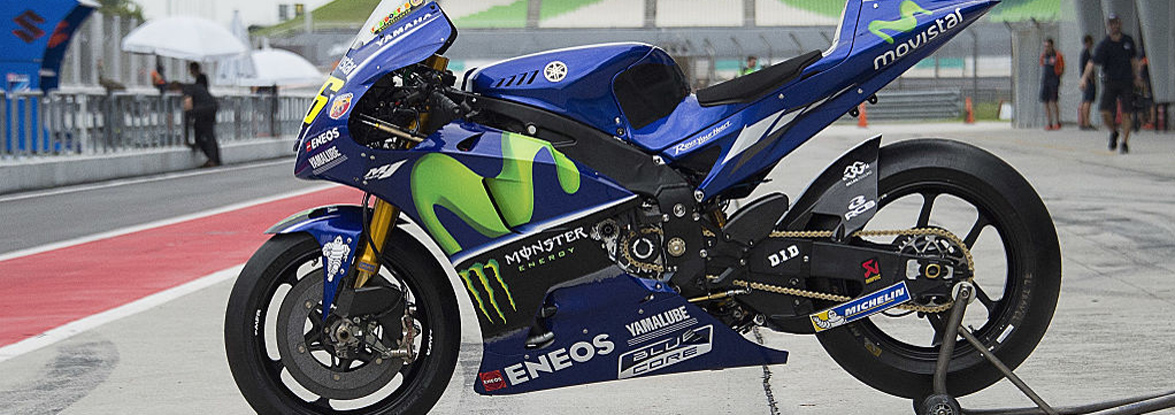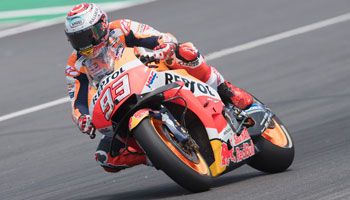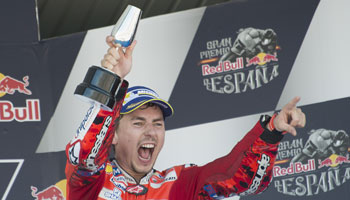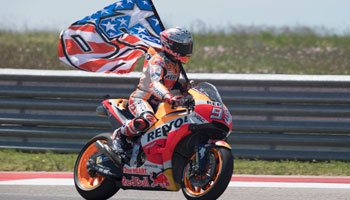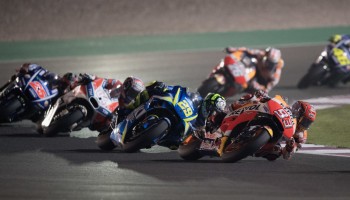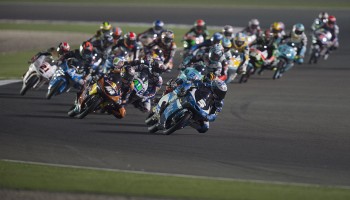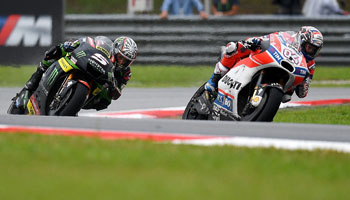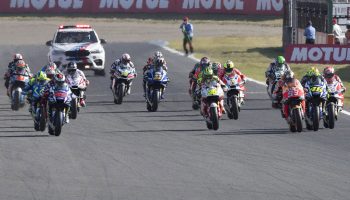Here Keith Huewen talks about the motor specifications and the tyres in Moto GP racing. For his expert view on more specific aspects of Moto GP racing, have a look at:
Moto GP qualifying and practice rules
Moto GP motor specifications
Can you tell us about the motor found in a Moto GP motorcycle? What are its specs?
“The typical motor is a 4-cylinder 1000cc non turbo 4-stroke. The ECU software on the control unit is specified and policed by the organisers – to avoid electronic trickery. V4 engines are found in some of the bikes, 4s in others, all with a 6 speed manual gearbox. The Ducati is without a doubt the fastest motorcycle on the racetrack, but new rules will reduce that gap. The independent bikes are within a few tenths of a second of the full factory spec bikes now.”
What is the power of a Moto GP bike?
“There is more power than tyre grip, only limited by electronics and bravery. No official figures are ever given but north of 290bhp would be a good bet! It’s interesting – the way engine size has gone up and down in MotoGP bikes has meant varying degrees of power, which are delivered to the rear wheel in different ways. MotoGP used to be 500cc, with 4-stroke (4T) and 2-stroke (2T) configurations, right up to 2002 – that was the cubic capacity limit of the engine up until that time. From the 2003 season on, it moved to 4-stroke and to 990cc – perhaps a strange capacity, but devised to equal the previous potency of the 500cc 2-strokes. Then it was 800cc from 2007 to 2012, which required a completely different riding style. But from 2012 until today, MotoGP has been competed on 1000cc machines. It’s a motorcycle that generally works well for both engineers and riders.
“The 500cc two-stroke bikes were incredibly fast and difficult to ride – we had no traction control back then, no launch control, no wheelie control and none of the electronic trickery that we now have. The complexity of a motorbike nowadays is incredible. The 500cc two-stroke engines were just flying machines, they were so powerful. I really liked two-stroke engines, but we’ve now moved to four-stroke engines. They are similar to road vehicles and that is where the manufacturers wanted to go with engine development. In theory, less cubic capacity is needed in a 2-stroke to achieve the same power as a larger 4-stroke engine.”
-
2016 bikes v 2017 bikes
What does two and four strokes mean?
“Power from a two-stroke (up and down piston movements) is generated at every revolution of the crankshaft. Four-strokes generate power (firing) every two revolutions. Although cheap to manufacture, 2-strokes were environmentally unacceptable and so we moved to the comparatively ‘softer’ power delivery of 4-strokes.
“Naturally, two-stroke engines are more powerful but there’s a lot of mechanical engineering involved, so it’s not easy to explain where we’ll all end up in the future.”
How much does the Moto GP bike typically weigh?
“157 kilograms is the minimum weight. When your bike weighs less that that, you break a technical qualification and are immediately disqualified. If you break a rule, you’re out of the door – that’s what I love about the rulebook. These weight limits don’t take into account the rider, like they do in Moto2 and 3.
“I asked Danny Aldridge, the technical director at Moto GP, why they don’t include the riders’ weight in restrictions. They felt it doesn’t make much difference. These bikes are so powerful, with so much horsepower, that added weight doesn’t make much difference. In Moto2 and Moto3, a few kilograms make a massive difference. Including the rider’s weight also drew opposition from a few teams.”
How much would a Moto GP bike cost?
“There is no cap on what full-factory teams such as Honda, Ducati, Yamaha or Suzuki can spend on bikes. Independent smaller teams, however, are supplied by those previously mentioned big manufacturers. There’s a cap on how much a manufacturer can charge an independent team for the lease of that bike – the independent teams don’t own the bikes, they are leased from the manufacturers. The cost of a leased MotoGP is around £2million.”
Moto GP tyres
Can you go through the different types of tyres used?
“Tyres are a major issue. It’s the one thing teams set their motorcycle up around. If you don’t use your tyres economically, you will be affected somewhere further down the race. Teams and riders will spend a disproportionate amount of time in the pre-practice on two things – track condition and tyres and their grip. The aim is to switch tyres at the right time. From 2009 until 2015, Bridgestone were the single suppliers of tyres for Moto GP. Since 2015, it has been Michelin. The riders I’ve spoken to are really happy with the new tyres. We’re seeing record times.
“Tyres are classified by a coloured banding around them. Yellow denotes a hard tyre, black (unmarked) is medium, white is soft. Tyre compounds can be symmetric or asymmetric. Symmetric ones have the same compound across the entire surface. Assymetric ones have a harder compound on one side and a softer one on the other. The latter are useful for tracks with more demanding turns on one side of the tyre than on the other. There’s wet and dry tyres. Last year, Michelin brought in intermediates for use in damp conditions, although I don’t expect to see them again.”

Moto GP betting
Moto GP is not only an extremely exciting sport to watch, but also to bet on. Fans can choose from a number of betting options, both on the Championship and the individual Grand Prix races.
Betting rules
Just like Moto GP and any other sport, betting has its rules, designed for maximum playing pleasure and fair play. Here, you can see how we make betting on sports fun, fair and easy for everyone.


